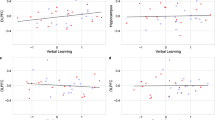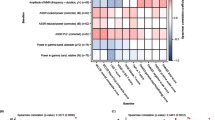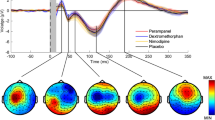Abstract
The poor translatability between preclinical and clinical drug trials has limited pro-cognitive therapeutic development. Future pro-cognitive drug trials should use translatable cross-species cognitive tasks with biomarkers (1) relevant to specific cognitive constructs, and (2) sensitive to drug treatment. Here, we used a difficulty-modulated variant of a cross-species cognitive control task with simultaneous electroencephalography (EEG) to identify neurophysiological biomarkers sensitive to the pro-cognitive effects of dextroamphetamine (d-amp) (10 or 20 mg) in healthy adults (n = 23), in a randomized, placebo-controlled, counterbalanced, double blind, within-subject study, conducted across three test days each separated by one week. D-amp boosted d-prime, sped reaction time, and increased frontal P3a amplitude to non-target correct rejections independent of task difficulty. Task difficulty did however, moderate d-amp effects on EEG during target performance. D-amp suppressed frontal theta power during easy target responses which negatively correlated with drug-induced improvement in hit rate while d-amp-induced changes in P3b amplitude during hard target trials strongly correlated with drug-induced improvement in hit rate. In summary, d-amp affected both behavioral and neurophysiological measures of cognitive control elements. Under low-demand, d-amp diminished cognitive control by suppressing theta, yet under high-demand it boosted control in concert with higher P3b amplitudes. These findings thus appear to reflect a gain-sharpening effect of d-amp: during high-demand processes were boosted while during low-demand processes were neglected. Future studies will use these neurophysiological measures of cognitive control as biomarkers to predict d-amp sensitivity in people with cognitive control deficits, including schizophrenia.
Similar content being viewed by others
Log in or create a free account to read this content
Gain free access to this article, as well as selected content from this journal and more on nature.com
or
Data availability
All data and Matlab code to re-create these analyses are available at OpenNeuro.org, accession #[WILL BE COMPLETED UPON ACCEPTANCE].
References
Harvey PD, Bowie CR. Cognitive enhancement in schizophrenia: pharmacological and cognitive remediation approaches. Psychiatr Clin North Am. 2012;35:683–98. https://doi.org/10.1016/j.psc.2012.06.008.
Carter CS, Barch DM. Cognitive neuroscience-based approaches to measuring and improving treatment effects on cognition in schizophrenia: the CNTRICS initiative. Schizophr Bull. 2007;33:1131–37. https://doi.org/10.1093/schbul/sbm081.
National Institute of Mental Health. Research domain criteria. 2013. http://www.nimh.nih.gov/research-priorities/rdoc/nimh-researchdomain-criteria-rdoc.shtml.
Cavanagh JF, Gregg D, Light GA, Sharp RF, Bismark AW, Bhakta SG, et al. Electrophysiological biomarkers of behavioral dimensions from cross-species paradigms. Transl Psychiatry. 2021;11:482. https://doi.org/10.1038/s41398-021-01562-w.
Cope ZA, Young JW. The five-choice continuous performance task (5C-CPT): a cross-species relevant paradigm for assessment of vigilance and response inhibition in Rodents. Curr Protoc Neurosci. 2017;78:9.56.1–18. https://doi.org/10.1002/cpns.20.
Lustig C, Kozak R, Sarter M, Young JW, Robbins TW. CNTRICS final animal model task selection: control of attention. Neurosci Biobehav Rev. 2013;37:2099–110. https://doi.org/10.1016/j.neubiorev.2012.05.009.
Young JW, Roberts BZ, Breier M, Swerdlow NR. Amphetamine improves rat 5-choice continuous performance test (5C-CPT) irrespective of concurrent low-dose haloperidol treatment. Psychopharmacology. 2020;237:1959–972. https://doi.org/10.1007/s00213-020-05511-1.
MacQueen DA, Minassian A, Kenton JA, Geyer MA, Perry W, Brigman JL, et al. Amphetamine improves mouse and human attention in the 5-choice continuous performance test. Neuropharmacology. 2018a;138:87–96. https://doi.org/10.1016/j.neuropharm.2018.05.034.
Bhakta SG, Young JW. The 5-choice continuous performance test (5C-CPT): a novel tool to assess cognitive control across species. J Neurosci Methods. 2017;292:53–60.
Young JW, Light GA, Marston HM, Sharp R, Geyer MA. The 5-choice continuous performance test: evidence for a translational test of vigilance for mice. PLoS ONE. 2009;4:e4227. https://doi.org/10.1371/journal.pone.0004227.
Young JW, Meves JM, Geyer MA. Nicotinic agonist-induced improvement of vigilance in mice in the 5-choice continuous performance test. Behavi Brain Res. 2013;240:119–33. https://doi.org/10.1016/j.bbr.2012.11.028.
Young JW, Powell SB, Scott CN, Zhou X, Geyer MA. The effect of reduced dopamine D4 receptor expression in the 5-choice continuous performance task: separating response inhibition from premature responding. Behav Brain Res. 2011;222:183–92. https://doi.org/10.1016/j.bbr.2011.03.054.
Braver TS, Reynolds JR, Donaldson DI. Neural mechanisms of transient and sustained cognitive control during task switching. Neuron. 2003;39:713–26. https://doi.org/10.1016/s0896-6273(03)00466-5.
Doege K, Kumar M, Bates AT, Das D, Boks MP, Liddle PF. Time and frequency domain event-related electrical activity associated with response control in schizophrenia. Clin Neurophysiol. 2010;121:1760–71. https://doi.org/10.1016/j.clinph.2010.03.049.
Dove A, Pollmann S, Schubert T, Wiggins CJ, von Cramon DY. Prefrontal cortex activation in task switching: an event-related fMRI study. Brain Res. Cogn Brain Res. 2000;9:103–9. https://doi.org/10.1016/s0926-6410(99)0009-4.
Miller EK. The prefrontal cortex and cognitive control. Nat Rev Neurosci. 2000;1:59–65. https://doi.org/10.1038/35036228.
Ridderinkhof KR, van den Wildenberg WP, Segalowitz SJ, Carter CS. Neurocognitive mechanisms of cognitive control: the role of prefrontal cortex in action selection, response inhibition, performance monitoring, and reward-based learning. Brain Cogn. 2004;56:129–40. https://doi.org/10.1016/jbandc2004.09.016.
Bhakta SG, Light GA, Talledo JA, Balvaneda B, Hughes E, Alvarez A, et al. Tolcapone-enhanced neurocognition in healthy adults: neural basis and predictors. Int J Neuropsychopharmacol. 2017;20:979–87. https://doi.org/10.1093/ijnp/pyx074.
Parasuraman R, Mutter SA, Molloy R. (1991). Sustained attention following mild closed-head injury. J Clin Exp Neuropsychol. 1991;13:789–811. https://doi.org/10.1080/01688639108401090.
Mass R, Wolf K, Wagner M, Haasen C. Differential sustained attention/vigilance changes over time in schizophrenics and controls during a degraded stimulus continuous performance test. Eur Arch Psychiatry Clin Neurosci. 2000;250:24–30. https://doi.org/10.1007/pI0000753.
Chen WJ, Faraone SV. Sustained attention deficits as markers of genetic susceptibility to schizophrenia. Am J Med Genet. 2000;97:52–7. 10.1002/(sici)1096-8628(200021)97:1<52::aid-ajmg7>3.0.co;2-6.
Barch DM, Berman MG, Engle R, Jones JH, Jonides J, Macdonald A 3rd, et al. CNTRICS final task selection: working memory. Schizophr Bull. 2009;35:136–52. https://doi.org/10.1093/schbul/sbn153.
Shalev N, Humphreys G, Demeyere N. Manipulating perceptual parameters in a continuous performance task. Behav Res. Methods. 2018;50:380–91. https://doi.org/10.3758/s13428-017-0877-7.
Cavanagh JF, Frank MJ. Frontal theta as a mechanism for cognitive control. Trends Cogn Sci. 2014;18:414–21. https://doi.org/10.1016/j.tics.2014.04.012.
Wessel JR, Aron AR. It’s not too late: the onset of the frontocentral P3 indexes successful response inhibition in the stop-signal paradigm. Psychophysiology. 2015;52:472–80. https://doi.org/10.1111/psyp.12374.
Donchin E. Presidential address, 1980. Surprise!… Surprise? Psychophysiology. 1981;18:493–513. https://doi.org/10.1111/j.1469-8986.1981.tb01815.x.
Johnson R Jr. A triarchic model of P300 amplitude. Psychophysiology. 1986;23:367–84. https://doi.org/10.1111/j.1469-8986.1986.tb00649.x.
Nieuwenhuis S, Aston-Jones G, Cohen JD. Decision making, the P3, and the locus coeruleus-norepinephrine system. Psychol Bull. 2005;131:510–32. https://doi.org/10.1037/0033-2909.131.4.510.
Polich J. Updating P300: an integrative theory of P3a and P3b. Clin Neurophysiol. 2007;118:2128–48. https://doi.org/10.1016/j.clinph.2007.04.019.
Ford JM, White P, Lim KO, Pfefferbaum A. Schizophrenics have fewer and smaller P300s: a single-trial analysis. Biol Psychiatry. 1994;35:96–103. https://doi.org/10.1016/0006-3223(94)91198-3.
Jocham G, Ullsperger M. Neuropharmacology of performance monitoring. Neurosci Biobehav Rev. 2009;33:48–60. https://doi.org/10.1016/j.neubiorev.2008.08.011.
Swerdlow NR, Bhakta SG, Talledo JA, Franz DM, Hughes EL, Rana BK, et al. Effects of amphetamine on sensorimotor gating and neurocognition in antipsychotic-medicated schizophrenia patients. Neuropsychopharmacology. 2018;43:708–17. https://doi.org/10.1038/npp.2017.285.
Barch DM, Carter CS. Amphetamine improves cognitive function in medicated individuals with schizophrenia and in healthy volunteers. Schizophr Res. 2005;77:43–58. https://doi.org/10.1016/j.schres.2004.12.019.
Goldberg TE, Bigelow LB, Weinberger DR, Daniel DG, Kleinman JE. Cognitive and behavioral effects of the coadministration of dextroamphetamine and haloperidol in schizophrenia. Am J Psychiatry. 1991;148:78–84. https://doi.org/10.1176/ajp.148.1.78.
First MB, Spitzer RL, Gibbon M, Williams JBW. Structured clinical interview for DSM-IV-TR axis I disorders, research version, non-patient edition. (SCID-I/NP): Biometrics Research. New York: New York State Psychiatric Institute; 2002.
Chou HH, Talledo JA, Lamb SN, Thompson WK, Swerdlow NR. Amphetamine effects on MATRICS consensus cognitive battery performance in healthy adults. Psychopharmacology. 2013;227:165–76. https://doi.org/10.1007/s00213-012-2948-x.
Wilkinson GS, Robertson GJ. Wide range achievement test—Fourth edition: Professional manual. Lutz, FL: Psychological Assessment Resources; 2006.
Green MF, Nuechterlein KH, Gold JM, Barch DM, Cohen J, Essock S, et al. Approaching a consensus cognitive battery for clinical trials in schizophrenia: the NIMH-MATRICS conference to select cognitive domains and test criteria. Biol Psychiatry. 2004;56:301–7. https://doi.org/10.1016/j.biopsych.2004.06.023.
Swerdlow NR, Stephany N, Wasserman LC, Talledo J, Shoemaker J, Auerbach PP. Amphetamine effects on prepulse inhibition across-species: replication and parametric extension. Neuropsychopharmacology. 2003;28:640–50. https://doi.org/10.1038/sj.npp.1300086.
Talledo JA, Sutherland Owens AN, SchortinghuisT, Swerdlow NR. Amphetamine effects on startle gating in normal women and female rats. Psychopharmacology. 2009;204:165–75. https://doi.org/10.1007/s00213-008-1446-7.
Green DM, Swets JA. Signal detection theory and psychophysics. New York: Wiley & Sons; 1966.
McNicol D. A primer of signal detection theory. London: George Allen & Unwin; 1972.
Frey PW, Colliver JA. Sensitivity and responsivity measures for discrimination learning. Learn Motiv. 1973;4:327–42.
Nolan H, Whelan R, Reilly RB. FASTER: fully automated statistical thresholding for EEG artifact rejection. J Neurosci Methods. 2010;192:152–62. https://doi.org/10.1016/j.jneumeth.2010.07.015.
Delorme A, Makeig S. EEGLAB: an open source toolbox for analysis of single-trial EEG dynamics including independent component analysis. J Neurosci Methods. 2004;134:9–21. https://doi.org/10.1016/j.jneumeth.2003.10.009.
MacQueen DA, Minassian A, Henry BL, Geyer MA, Young JW, Perry W. Amphetamine modestly improves Conners’ continuous performance test performance in healthy adults. J Int Neuropsychol Soc. 2018b;24:283–93. https://doi.org/10.1017/S135561771700090X.
Ilieva IP, Hook CJ, Farah MJ. Prescription stimulants’ effects on healthy inhibitory control, working memory, and episodic memory: a meta-analysis. J Cogn Neurosci. 2015;27:1069–89. https://doi.org/10.1162/jocn_a_00776.
Stige S, Fjell AM, Smith L, Lindgren M, Walhovd KB. The development of visual P3a and P3b. Dev Neuropsychol. 2007;32:563–84. https://doi.org/10.1080/87565640701361096.
Nieuwenhuis S, Yeung N, van den Wildenberg W, Ridderinkhof KR. Electrophysiological correlates of anterior cingulate function in a go/no-go task: effects of response conflict and trial type frequency. Cogn Affect Behav Neurosci. 2003;3:17–26. https://doi.org/10.3758/cabn.3.1.17.
Greenhouse I, Wessel JR. EEG signatures associated with stopping are sensitive to preparation. Psychophysiology. 2013;50:900–8. https://doi.org/10.1111/psyp.12070.
O’Connell RG, Dockree PM, Kelly SP. A supramodal accumulation-to-bound signal that determines perceptual decisions in humans. Nat Neurosci. 2012;15:1729–35. https://doi.org/10.1038/nn.3248.
Philiastides MG, Heekeren HR, Sajda P. Human scalp potentials reflect a mixture of decision-related signals during perceptual choices. J Neurosci. 2014;34:16877–89. https://doi.org/10.1523/JNEUROSCI.3012-14.2014.
Twomey DM, Murphy PR, Kelly SP, O’Connel RG. The classic P300 encodes a build-to-threshold decision variable. Eur J Neurosci. 2015;42:1636–43. https://doi.org/10.1111/ejn.12936.
Acknowledgements
We would like to thank Dr. Mark A. Geyer and Ms. Mahalah R. Buell for their support and Ms. Maria Bongiovanni for assistance with preparation of manuscript.
Funding
The current project was funded by NIMH UH3 MH109168 and R01DA043535.
Author information
Authors and Affiliations
Contributions
SGB: conceptualization, methodology, writing—original draft, investigation, data curation, supervision, project administration, funding acquisition. JFC: conceptualization, methodology, software, formal analysis, writing—original draft, funding acquisition. GAL: conceptualization, methodology, resources, writing—review and editing, funding acquisition. NRS: conceptualization, methodology, writing—review and editing, investigation, data curation, supervision, project administration, funding acquisition. LB, JAT, JEK, BZR, and JAN: investigation, data curation, supervision, project administration. JLB and JWY: conceptualization, methodology, writing—review and editing, funding acquisition.
Corresponding author
Ethics declarations
Competing interests
JWY has received pharmaceutical funding from Sunovion Pharmaceuticals, Gilgamesh, and Heptares unrelated to the current work. All other authors report no biomedical financial interests of potential conflicts of interest.
Additional information
Publisher’s note Springer Nature remains neutral with regard to jurisdictional claims in published maps and institutional affiliations.
Supplementary information
Rights and permissions
About this article
Cite this article
Bhakta, S.G., Cavanagh, J.F., Talledo, J.A. et al. EEG reveals that dextroamphetamine improves cognitive control through multiple processes in healthy participants. Neuropsychopharmacol. 47, 1029–1036 (2022). https://doi.org/10.1038/s41386-021-01257-2
Received:
Revised:
Accepted:
Published:
Issue date:
DOI: https://doi.org/10.1038/s41386-021-01257-2
This article is cited by
-
Cigarette smoking is associated with reduced neuroinflammation and better cognitive control in people living with HIV
Neuropsychopharmacology (2025)



